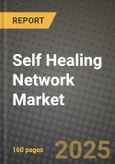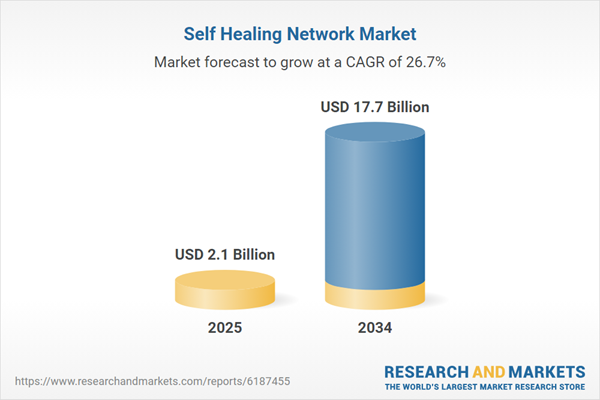The self-healing network market is gaining traction as organizations strive to improve network reliability, performance, and security in the face of increasing digital transformation. Self-healing networks are designed to detect and automatically repair faults or disruptions in network systems, improving uptime and reducing manual intervention. This market is particularly relevant in industries like telecommunications, IT services, and enterprise networking, where continuous network availability is critical for operations. By leveraging artificial intelligence (AI), machine learning (ML), and automation technologies, self-healing networks can identify network issues in real-time, quickly isolating the root cause and implementing fixes without human involvement. This functionality is essential in an era where network complexity is increasing, and the volume of data transmitted over networks continues to rise. The self-healing network market is also driven by growing demand for 5G networks, the increasing adoption of IoT devices, and the need for resilient infrastructure. As organizations face pressures to enhance security and minimize downtime, the demand for self-healing networks is set to grow rapidly. With the ability to minimize disruptions and ensure a smooth user experience, these networks promise to significantly improve the performance and security of digital infrastructures.
The self-healing network market saw substantial growth due to the increasing reliance on automation and AI technologies across industries. The telecommunications sector, in particular, made significant strides in deploying self-healing solutions to enhance the resilience and performance of 5G networks. With the rapid deployment of 5G infrastructure worldwide, operators faced challenges in managing network traffic, ensuring uptime, and maintaining seamless connectivity. Self-healing networks equipped with AI-powered automation provided a solution by enabling real-time monitoring, fault detection, and proactive resolution of issues before they escalated. Additionally, the IT services sector began to adopt self-healing networks to support their growing enterprise customers, who demand uninterrupted access to applications and services. The integration of machine learning algorithms into self-healing network solutions allowed these systems to learn from past disruptions, improving their ability to anticipate and address issues autonomously. Furthermore, the market expanded as more organizations adopted IoT solutions, creating a need for self-healing networks that can manage the increased complexity and volume of connected devices. Despite advancements, challenges such as high implementation costs and the need for skilled professionals to manage these sophisticated systems remained as obstacles to broader adoption.
The self-healing network market is poised for further expansion, driven by technological advancements and increasing demand for robust digital infrastructure. The ongoing deployment of 5G networks and the rise of edge computing will significantly accelerate the adoption of self-healing networks, as these systems are essential for maintaining performance in highly distributed, data-intensive environments. Additionally, as organizations continue to embrace IoT and smart devices, the need for self-healing networks capable of managing vast networks of connected devices will become even more critical. The growth of the cloud-based infrastructure market, coupled with an increasing reliance on hybrid and multi-cloud environments, will further push the demand for autonomous, self-healing network solutions. AI and ML technologies will continue to advance, allowing self-healing networks to become more sophisticated in identifying and resolving potential issues, ensuring greater network uptime and improved user experience. However, challenges related to the cost of implementation, the complexity of integration into existing infrastructures, and data privacy concerns could hinder widespread adoption. Overall, the self-healing network market is expected to play a central role in the future of network management, providing organizations with a smarter, more efficient way to manage their digital infrastructure.
Key Insights: Self Healing Network Market
- Increasing adoption of self-healing networks in telecommunications for 5G network resilience and optimization.
- Advancements in AI and ML technologies that enhance the capabilities of self-healing networks to autonomously detect and resolve issues.
- Rising demand for self-healing networks driven by the rapid expansion of IoT devices and the complexity of managing connected environments.
- Growing reliance on edge computing and distributed architectures, driving the need for self-healing solutions in decentralized networks.
- Continued focus on enhancing network security by automating responses to vulnerabilities and threats in real-time.
- Increased demand for 5G networks and IoT applications, which require robust, automated network management solutions.
- Technological advancements in AI, ML, and automation, enabling more efficient and effective self-healing network capabilities.
- Rising need for continuous network availability in industries such as telecommunications, IT services, and finance.
- Greater focus on improving network security by proactively addressing vulnerabilities through automation and real-time fault resolution.
- High initial investment costs and the complexity of integrating self-healing networks into existing infrastructure remain significant barriers to adoption.
Self Healing Network Market Segmentation
By Component
- Solutions
- Services
By Network Type
- Physical
- Virtual
- Hybrid
By Deployment Mode
- On-Premises
- Cloud
By Applications
- Network Provisioning
- Network Bandwidth Monitoring
- Policy Management
- Security Compliance Management
- Root Cause Analysis
- Network Traffic Management
- Network Access Control
- Other Applications
By Verticals
- Information Technology and Information Technology Enabled Services (IT and ITES)
- Banking
- Financial Services and Insurance
- Media and Entertainment
- Healthcare and Life Sciences
- Telecom
- Retail and Consumer Goods
- Education
- Other Verticals
Key Companies Analysed
- Cisco Systems Inc.
- Nokia Corporation
- Huawei Technologies Co. Ltd.
- Telefonaktiebolaget LM Ericsson
- International Business Machines Corporation
- Fortra LLC
- Versa Networks Inc.
- IIvanti Inc.
- VMware Inc.
- CommScope Holding Company Inc.
- Appnomic Systems Pvt. Ltd.
- Verizon Communications Inc.
- Broadcom Inc.
- Infosys Limited
- BT Group plc
- Elisa Corporation
- Juniper Networks Inc.
- Arista Networks Inc.
- Extreme Networks Inc.
- Ciena Corporation
- Hewlett Packard Enterprise Company
- Dell Technologies Inc.
- NEC Corporation
- Fujitsu Limited
- Riverbed Technology Inc.
- Infovista Corporation
- Netcracker Technology Corp.
- Spirent Communications plc
- Anuta Networks International LLC
- 128 Technology Inc.
- Gluware Inc.
Self Healing Network Market Analytics
The report employs rigorous tools, including Porter’s Five Forces, value chain mapping, and scenario-based modeling, to assess supply-demand dynamics. Cross-sector influences from parent, derived, and substitute markets are evaluated to identify risks and opportunities. Trade and pricing analytics provide an up-to-date view of international flows, including leading exporters, importers, and regional price trends.
Macroeconomic indicators, policy frameworks such as carbon pricing and energy security strategies, and evolving consumer behavior are considered in forecasting scenarios. Recent deal flows, partnerships, and technology innovations are incorporated to assess their impact on future market performance.Self Healing Network Market Competitive Intelligence
The competitive landscape is mapped through proprietary frameworks, profiling leading companies with details on business models, product portfolios, financial performance, and strategic initiatives. Key developments such as mergers & acquisitions, technology collaborations, investment inflows, and regional expansions are analyzed for their competitive impact. The report also identifies emerging players and innovative startups contributing to market disruption.
Regional insights highlight the most promising investment destinations, regulatory landscapes, and evolving partnerships across energy and industrial corridors.Countries Covered
- North America - Self Healing Network market data and outlook to 2034
- United States
- Canada
- Mexico
- Europe - Self Healing Network market data and outlook to 2034
- Germany
- United Kingdom
- France
- Italy
- Spain
- BeNeLux
- Russia
- Sweden
- Asia-Pacific - Self Healing Network market data and outlook to 2034
- China
- Japan
- India
- South Korea
- Australia
- Indonesia
- Malaysia
- Vietnam
- Middle East and Africa - Self Healing Network market data and outlook to 2034
- Saudi Arabia
- South Africa
- Iran
- UAE
- Egypt
- South and Central America - Self Healing Network market data and outlook to 2034
- Brazil
- Argentina
- Chile
- Peru
Research Methodology
This study combines primary inputs from industry experts across the Self Healing Network value chain with secondary data from associations, government publications, trade databases, and company disclosures. Proprietary modeling techniques, including data triangulation, statistical correlation, and scenario planning, are applied to deliver reliable market sizing and forecasting.Key Questions Addressed
- What is the current and forecast market size of the Self Healing Network industry at global, regional, and country levels?
- Which types, applications, and technologies present the highest growth potential?
- How are supply chains adapting to geopolitical and economic shocks?
- What role do policy frameworks, trade flows, and sustainability targets play in shaping demand?
- Who are the leading players, and how are their strategies evolving in the face of global uncertainty?
- Which regional “hotspots” and customer segments will outpace the market, and what go-to-market and partnership models best support entry and expansion?
- Where are the most investable opportunities - across technology roadmaps, sustainability-linked innovation, and M&A - and what is the best segment to invest over the next 3-5 years?
Your Key Takeaways from the Self Healing Network Market Report
- Global Self Healing Network market size and growth projections (CAGR), 2024-2034
- Impact of Russia-Ukraine, Israel-Palestine, and Hamas conflicts on Self Healing Network trade, costs, and supply chains
- Self Healing Network market size, share, and outlook across 5 regions and 27 countries, 2023-2034
- Self Healing Network market size, CAGR, and market share of key products, applications, and end-user verticals, 2023-2034
- Short- and long-term Self Healing Network market trends, drivers, restraints, and opportunities
- Porter’s Five Forces analysis, technological developments, and Self Healing Network supply chain analysis
- Self Healing Network trade analysis, Self Healing Network market price analysis, and Self Healing Network supply/demand dynamics
- Profiles of 5 leading companies - overview, key strategies, financials, and products
- Latest Self Healing Network market news and developments
Additional Support
With the purchase of this report, you will receive:- An updated PDF report and an MS Excel data workbook containing all market tables and figures for easy analysis.
- 7-day post-sale analyst support for clarifications and in-scope supplementary data, ensuring the deliverable aligns precisely with your requirements.
- Complimentary report update to incorporate the latest available data and the impact of recent market developments.
This product will be delivered within 1-3 business days.
Table of Contents
Companies Mentioned
- Cisco Systems Inc.
- Nokia Corporation
- Huawei Technologies Co. Ltd.
- Telefonaktiebolaget LM Ericsson
- International Business Machines Corporation
- Fortra LLC
- Versa Networks Inc.
- IIvanti Inc.
- VMware Inc.
- CommScope Holding Company Inc.
- Appnomic Systems Pvt. Ltd.
- Verizon Communications Inc.
- Broadcom Inc.
- Infosys Limited
- BT Group PLC
- Elisa Corporation
- Juniper Networks Inc.
- Arista Networks Inc.
- Extreme Networks Inc.
- Ciena Corporation
- Hewlett Packard Enterprise Company
- Dell Technologies Inc.
- NEC Corporation
- Fujitsu Limited
- Riverbed Technology Inc.
- Infovista Corporation
- Netcracker Technology Corp.
- Spirent Communications PLC
- Anuta Networks International LLC
- 128 Technology Inc.
- Gluware Inc.
Table Information
| Report Attribute | Details |
|---|---|
| No. of Pages | 160 |
| Published | October 2025 |
| Forecast Period | 2025 - 2034 |
| Estimated Market Value ( USD | $ 2.1 Billion |
| Forecasted Market Value ( USD | $ 17.7 Billion |
| Compound Annual Growth Rate | 26.6% |
| Regions Covered | Global |
| No. of Companies Mentioned | 31 |









